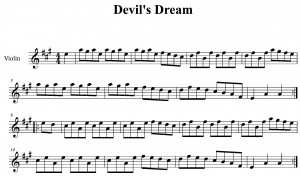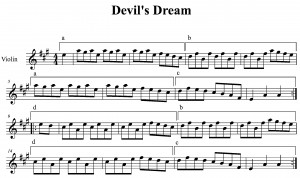Tips & Tricks: The Anatomy of a Fiddle Tune
In learning the fiddle, it can be very handy to know the anatomy of a fiddle tune. The general structure of a fiddle tune is quite simple, although, as with all rules, there can always be exceptions!
The basic structure of a fiddle tune as a whole is that there are two parts. The first half of the tune is called “A” and the second half of the tune is called “B”. Each one of these is usually played twice. In this example, we are using the tune “Devil’s Dream”.
If we now look at the A part of the fiddle tune, you will notice that it is 8 bars long. This is pretty typical. The first two bars are repeated in bars 5 and 6. Let’s use lower case letters to represent these two bar segments. We now have a, b, a, c.
Now let’s look at the second half of the fiddle tune. Again, bars 10 and 11 are repeated in bars 14 and 15. Also, if we look at both the A and B parts, you will notice that bars 3 and 4 are the same as are bars 12 and 13. Bars 7 and 8 are the same as 16 and 17.
Now the overall structure looks like this: A = a, b, a, c played twice, B = d, b, d, c played twice.
As I said before, not all fiddle tunes use this structure, however, many do. This knowledge can be useful as it makes both learning and memorizing tunes not seem quite so daunting. Now instead of having 16 bars to learn, there are many fewer because so many of them repeat. I also find this useful as far as figuring tunes out by ear, either from a recording or at a jam session.
I hope this information helps you in learning, perfecting and memorizing fiddle tunes!




